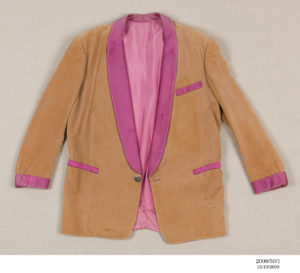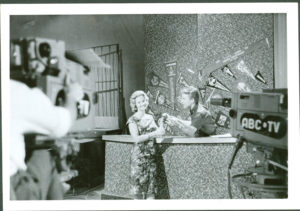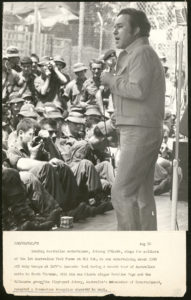From its very beginnings, rock n roll has argued with itself over image. Is the rock image glam, flashy, showy and gregarious? Or is it honest, dirty, working class and brash? Regardless, ‘look’ has always played a massive part in rock n roll.
Australia’s first real rocker, Johnny O’Keefe, took the visuals of his performance very seriously. Johnny would exhaust all his energy and his voice at each performance. O’Keefe’s stage attire developed with his stage shows, and up until the late 1960s, loud, over-the-top suits were one of his trademarks. The Museum has in its impressive Johnny O’Keefe collection three suits Johnny wore for his performances.
![Mens suit consisting of jacket and trousers, worn by Johnny O'Keefe. -1 Jacket made of red fabric with black and cream coloured 'leopard print' velvet trimming at collar, cuffs and pockets. The jacket has a shawl collar with the collar and lapels lined with leopard print velvet which extends on the inside of the jacket to the waist. The jacket fastens at the waist with a single black plastic button which is sewn to the jacket with red cotton. The jacket is long sleeved and the cuffs are trimmed with leopard print velvet. The jacket has a fake external left breast pocket and two fake external waist pockets on the left and right sides, all pockets are trimmed with leopard print velvet. There are no internal pockets. The inside of the jacket is lined with a red [silk] fabric and leopard print velvet lines the collar and lapel area extending to the waist. The shoulders are slightly padded. The jacket has several moth holes including two on the back of the right shoulder and two below the button. The lining has a hole at the neck and is torn at each armhole and has detatched from the velvet below the buttonhole. The velvet lining is worn around the neck and above the button. -2 Trousers made of red fabric, matching trousers to jacket (98/32/2-1). Trousers have 2 side pockets and a coin pocket at the waist on the right side. Inside of pockets are made of a cream cotton fabric. Trousers are pleated at the waist at the front and back and have 4 wide belt loops formed in the pleats and one thin belt loop and the centre back of the waist which has a safety pin attached. Trousers fasten at the centre front with a metal zipper, a metal hook and eye and an internal button on the left side of the waist which fastens to a buttonhole on a triangular extension of red fabric on the right side. The trousers are unlined except for the inside waistband which is lined with a band of cream ribbed silk and the zipper which is lined with black [silk] fabric. The trousers are hemmed to give the appearence of turned up cuffs at the hem of each leg. The fabric forming the inside of the right pocket has a handwritten inscription in black ink, 'O'Keefe's [sic]/3483'. There are white marks on the legs and repairs have been made to the crotch area.](Johnny O’Keefe_ 40 year anniversary of losing Australia’s first rocker – Inside the Collection_files/DS-1136-0122_edited-240x300.jpg)
The red suit was likely made by Johnny’s mother, Thelma O’Keefe, in the late 1950s. This outfit, complete with velvet leopard-skin collar, and red and gold shoes decorated with fringed leather and studded with faux emeralds exemplifies O’Keefe’s taste for bold, but elegant flashiness.
![Men's suit consisting of jacket and trousers, worn by Johnny O'Keefe. -1 Jacket made of yellow [cotton] fabric with black velvet trimming at collar, cuffs and pockets. The jacket has a shawl collar with the neck area trimmed with black velvet decorated with a string of diamantes around the neck. The lapels are of the same yellow fabric and extend to the single button fastening at the waist. The button is made of brownish-black plastic. The jacket is long sleeved and the cuffs are trimmed with black velvet decorated with a string of diamantes around the front half of both cuffs, some diamantes are missing from both cuffs. The jacket has a fake external left breast pocket trimmed with black velvet and diamantes, one diamante appears to be missing from the end of the string. The jacket also has two fake external waist pockets on the left and right sides which are trimmed with black velvet. The jacket is lined with salmon pink silk and has no internal pockets, the shoulders have some padding. A maker's label is sewn inside the jacket at the left breast, the label is cream coloured with black embroidered text "Len Taylor/Sydney/American Clothes Stylist". The label is partly detached from the jacket. The jacket has black marks exteding horizontally from just above the right waist pocket and discolouration in the lining at the centre back neck area and in various places on the external yellow fabric. There are several moth holes in the lining and in the external fabric particularly just below the right waist pocket. -2 Trousers made of yellow [cotton] fabric, matching trousers to jacket (98/32/1-1). Trousers have 2 side pockets and are pleated at the front of waist. Trousers fasten at centre front with a metal zipper, metal hook and eye and internal button which fastens to button hole on a triangular extension of yellow fabric (this internal button is missing). There are seven belt loops around waist for a thin belt. Trousers are unlined except for the inside waist which is lined with a band of ribbed cream silk, covering a rougher piece of hessian coloured fabric, the zipper is also lined with cream silk. The waistband lining is partially detached from the trousers. The legs of the trousers are hemmed with black velvet giving the appearence of a cuff at the hem of each leg. The cream cotton fabric forming the inside of the left pocket has a handwritten inscription in black ink "J.R O'Keef" [sic] and the fabric forming the inside right pocket has a handwritten inscription in black ink "FHC".](Johnny O’Keefe_ 40 year anniversary of losing Australia’s first rocker – Inside the Collection_files/DS-1136-0139_edited-240x300.jpg)
The gold suit, tailored by Len Taylor, Sydney, American Clothes Stylist, in the late 1950s, is only marginally less flashy than Johnny’s red suit.

Johnny’s beige and hot-pink suit was made by Sydney tailor Tony Bonnici in the late 1950s.
O’Keefe also became a television personality, hosting the programs Six O’Clock Rock (ABC, 1959 – 1961), Johnny O’Keefe Show (ATN-7, 1962), and then Sing Sing Sing, (ATN-7 1963). Johnny’s wardrobe on TV was conspicuously less flashy than his live performance outfits. Television is much more mainstream than live performance; moreover, television was black and white!

In becoming more mainstream, O’Keefe was more in demand. His workload was hectic, and his passionate personality made his moods swing unpredictably. Johnny had several emotional breakdowns requiring hospitalisation through the 1960s.
O’Keefe always supported and bolstered other Australian music acts through his live performances and his television shows. And although he himself had a wild image, it was clean-cut and tailored. The rock bands emerging out of England in the 1960s had a very different image. Long, messy hair, smart-mouthed and raw, the Mersey Beat phenomenon did not impress O’Keefe. Johnny wouldn’t allow local long-hairs to appear on his show Sing Sing Sing, and this put him at odds with youth culture. The Wild One did not seem all that wild – more like a cranky parent!

The Mersey Beat invasion and Beatle mania did not beat Johnn O’Keefe though. In 1969, O’Keefe entertained thousands of Australian troops in Vietnam, and a few years later, in 1974, his career took off again. His show, The Good Old Days of Rock’n’Roll, started at the St George Leagues Club in August that year and continued to tour Australia until his death. His song, Mockingbird, recorded with Margaret McLaren, became a hit. With his new wife, Maureen Joan Maricic, a fashion consultant, he opened a boutique, J. O’K Creations, at Paddington in 1978. Johnny died later that year, on 6 October – now forty years ago.

The Museum continues to celebrate Johnny O’Keefe’s celebrity, displaying one of his outfits in the Icons exhibition at the Powerhouse Museum.
Unfortunately, Johnny didn’t get to see glam and flashiness come back into rock n roll as it did in a big way in the 1970s, and again in the 1980s. It’s probably due to make another comeback too.
Written by Damian McDonald
I loved Johnny Okeefe…My best friend Celia and I went to many of his concerts back in late fifties…unbeknown to our parents..
Met Johnny okeefe in Adelaide. He was a beautiful person,with a heart of gold. Diana